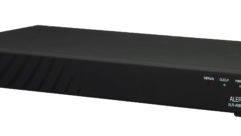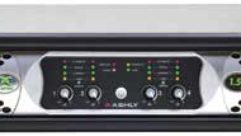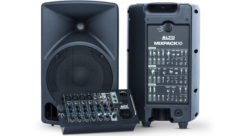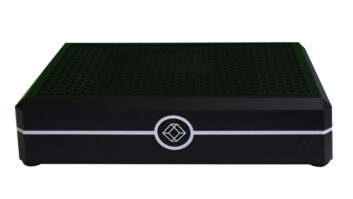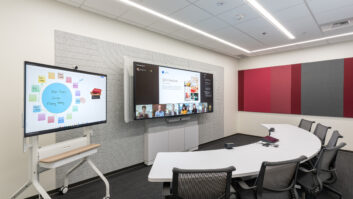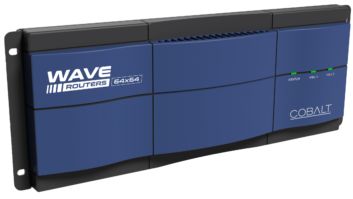
Technology Showcase:
Multichannel Power Amplifiers
May 1, 2005 12:00 PM,
By Bruce Borgerson
The niche goes mainstream.
Why install a multichannel power amplifier rather than two or more stereo equivalents? For the most part, it’s a no-brainer.
Crown CTs 4200
First, you have fewer units to order and transport, fewer pieces of equipment to install, fewer AC connections, and fewer monitoring/control connections when you use multichannel power amps. This cuts installation time and cost. Moreover, with most of today’s efficient multichannel amplifiers, less rack space is needed, AC power requirements are reduced, and unit costs per channel of amplification are cut significantly because redundant components — largely in power supplies — are eliminated. Consequently, both equipment and operating costs are lowered as well.
In light of the benefits, it’s hard to find a downside to the trend. To be sure, the lack of redundancy in power supplies means that more channels will go down in the event of a power supply failure. However, such catastrophes are quite rare and present an overriding obstacle in only the most critical applications. In the great majority of cases, the benefits of going multichannel outweigh the negatives. As a result, demand is accelerating, and makers are responding with a flurry of new amplifier introductions.
NEW TOPOLOGIES DRIVE THE TREND
The purpose of this article is to give a broad yet comprehensive overview of multichannel amplifiers for commercial sound installations. With the burgeoning number of products to cover, there is little space for discussion of recent developments in amplifier topologies. However, the newer design trends must be acknowledged because advancing circuit technologies are largely responsible for unleashing so many new multichannel models. The dramatic reduction in size and weight achieved by the new circuit topologies has made it possible to pack more channels inside one cabinet without producing a unit that is too big and heavy to wrestle in and out of a rack.
The first big step in size/weight reduction came decades ago with the advent of switched-mode power supplies. Refinements in this technology continue to shave excess weight. In recent years, the slimming trend has accelerated with the introduction of the new Class D and Class H circuits, each with proprietary variations. For the purposes of this article, it is assumed that all listed amplifiers will provide acceptable sonic performance in general commercial applications; therefore, amplifier topology is not listed as a primary criterion.

Lab.gruppen C series
OPTIONS, OPTIONS, MORE OPTIONS
Beyond declining size and weight, the multichannel market is trending toward mushrooming availability of more models, at more price points, and with more choices available to suit specific applications.
Another notable trend is the increasing availability of amplifiers that can split channel outputs — individually or in pairs — to drive either low-impedance or high-impedance (70V) systems without the installation of a transformer. Although you pay a premium for this feature, it’s often worth the added expense in mixed installations. Other amplifiers offer two versions, while still others offer optional internal or external transformers. Finally, jockeying for competitive advantage, manufacturers are offering extras for equalization, signal processing, control, monitoring, and networking. Some amplifiers have one or more extra features built in, while others offer them in optional plug-in modules. Also, following their stereo brethren, a few multichannel amplifiers now are offering optional digital audio input (via CobraNet) combined with proprietary control/monitoring on a single Ethernet connection.
Not all manufacturers offer all choices, but there’s an amplifier out there for just about every requirement, no matter how specialized. Most target the middle bulge of the market, offering outputs from 60W to 100W (@ 8Ω), but models are available ranging from 6W to 275W per channel. The most common input/output combination is a Euroblock (Phoenix) input with a screw terminal output, but ins and outs are available on virtually every common connector type. Some connectors aren’t common at all: To save precious rear-panel space, one recent entry has put balanced inputs for 16 channels on twin DB-25 connectors!
JUST THE FACTS
This overview makes no attempt to evaluate subjective qualities such as sonic performance, reliability, or the efficacy of circuit-protection features. The power output ratings in Chart 1 (pp. 77 and 78) are taken from published literature and should be considered a rough guide for general classification only, as there are variations in the distortion levels and specified bandwidth. When more than one specification is given, the most conservative is used here. Please refer to complete specifications on the manufacturers’ websites before making any final decisions.
The vast majority of multichannel power amplifiers incorporate all of the following features, with most exceptions noted in the text or in chart notes when known or deemed of importance:
- A two-, three-, or variable-speed fan
- Circuit-protection features for faults internally and in connected loudspeakers
- Rear-panel level controls. However, these can be trimpots or stepped attenuators.
- Bridging of adjacent channels for higher power output
- LED status indicators of some kind. Most offer several indicators per channel, while some have only a single multi-color LED to show signal present, clip, and fault.
All except a few of the lowest-cost models use universal power supplies, allowing worldwide use. Of those that do not, most offer a 230V nominal version.

Chart 1: Power output ratings for multichannel amps from several manufacturers. Numbers are taken from published literature and should be considered a rough guide for general classification only. Check the manufacturers’ websites for complete specifications.
Click here for a larger image.
WHAT’S IN, WHAT’S OUT
This overview encompasses those multichannel power amplifiers designed for a broad range of commercial sound applications. Integrated mixer/amplifiers with paging functions are not included, nor are amplifiers designed primarily for 5.1 surround sound in either commercial cinemas or home theater installations. Several high-powered amplifiers designed primarily for touring sound systems are noted at the end of the article, as they may be suited for larger, performance-oriented installations. Also noted are a few models suited to both residential and limited commercial applications.
Known primarily as a maker of automated digital playback systems, Alcorn McBride developed its innovative AmpTraxx 16-channel amplifier to meet the need for multiple channels in low-power applications such as museums, exhibits, and multilingual systems. The 2RU amplifier includes internal triband programmable equalization for each channel, accessed via serial connection using the included Windows-based control program. Inputs are RCA- or optional-balanced on dual DB-25 connectors. No bus selection is available, inputs can’t be bridged, and both power output and THD specifications point more to voice than hi-fi music applications. Nevertheless, in this corner of the market there’s really nothing else resembling it, which means AmpTraxx likely will find numerous applications apart from Alcorn McBride’s own source systems.
To support its established loudspeaker line, Altec Lansing offers two multichannel amplifiers: the 4-channel 4200A (275W per channel at 8Ω) and the 6-channel 6125A (150W per channel at 8Ω). Output circuits employ a switched MOSFET design with spread spectrum switching technology, but a more conventional power supply places these units in the middleweight category. The Altec amplifiers are targeted straight at the heart of the contractor market, with a 50Hz high-pass filter (switchable for output pairs), Euroblock inputs, and screw terminal outputs.
Ashly Audio’s low-impedance models — the Powerflex 4400 and 6250 — bear a striking resemblance to the Altec units, suggesting a possible OEM relationship. There are some differences, however. The inputs on the low-impedance Ashly units are both Euroblock and XLR/¼in. combination, and outputs are on five-way binding posts. This indicates Ashly is looking at other markets beyond rack installs for these two products, although it does claim that the Powerflex 6250 can drive 70V lines directly from bridged output pairs.
The other two amplifiers in the Ashly Powerflex line — the 4-channel 470 and the 6-channel 670 — revert to the standard Euroblock inputs and screw terminal outputs. Here, the intent is clearly installation, and outputs are specified for driving 70V systems. Although the Ashly units don’t break any power-to-size/weight barriers, they still fare nicely compared to individual stereo counterparts.
A surprisingly diversified small company based near Seattle, AudioControl Industrial has carved out a comfortable niche in the multichannel market by offering very high-density models with uncommon options. These amplifiers are targeted more at the home installation market but certainly have applications in everything from museums and trade show exhibits to office suites. The two established models are the 12-channel 510 and 710, identical except for the six-band output EQ on each channel of the 710. Performance is creditable, with 50W per channel at 0.12 percent THD, and high-efficiency design allows for fan-free convection cooling. Each channel has a defeatable signal-sense mute control. Other notable features include a high-pass filter programmable from 20Hz to 100Hz, independent or bus input assign, and remote power control input.
Brand-new to the company’s line are the 16-channel 960 and 961 models, again identical except for the six-band EQ on the latter. Although similar to the 12-channel models in many respects, these amplifiers use new Class H circuits to boost output to 60W/channel. Another notable addition is an Ethernet connection for remote status monitoring and control.
From the Land Down Under comes a brand-new offering from Australian Monitor, a company rapidly gaining recognition for its extensive line of digital paging equipment. Designed as an ideal complement to the company’s own line, though certainly with applications elsewhere, the AMIS480P produces 4 channels of 80W output while offering a number of unique extras. Each channel may be connected independently to either low-impedance or 70V systems, and each channel has its own ground lift switch for maximum isolation. Also, each channel has a link-through input switch, allowing any or all channels to tap the same input signal.
The two 8-channel models from Oregon-based Biamp Systems are identical except for the power output levels: 30W per channel for the 8050 and 90W for the 8150. Both are compact and contractor-friendly, with Euroblock inputs, screw terminal outputs, bridge mode, and high-pass filters switchable in pairs. Each amplifier also offers a basic remote control feature, with input VCAs accessible via a rear DB-55 connector for remote level control and mute of each channel individually. Optional internally mounted transformers accommodate applications requiring 70V operation.
U.K.-based Cloud Electronics is expanding worldwide distribution of its made-in-England amplifiers, which were developed to complement the company’s zone mixers. The line breaks down into two variants on two basic designs: The 4-channel CX-A4 and the 6-channel CX-A6 share the same amplifier modules (85W at 8Ω) and I/O configurations. Essentially, the same holds true of the 4-channel CX-A450 and CX-A850, the 4- and 8-channel variants offering 35W per channel at 8Ω. The CX-A450 can accommodate optional 70V transformers internally, with external transformer options for the other three models. Plug-in options include VCA level control (with or without peak limiting) and EQ modules specifically designed for selected Bose loudspeakers.
According to Crest Audio, its brand-new CMi series amplifiers are designed as vehicles to take the company’s amplifiers into the future of complete networked control and digital input by accommodating Crest’s new NxCobraNet-8 module. Based on a new proprietary Class D topology, the 4-channel CMi 2204 and 8-channel CMi 2208 are unique in a number of respects. First, the outputs are optimized for higher-impedance loads — which means that the 8Ω power rating is higher than the 4Ω — and, more importantly, 70V operation without bridging or transformers. Channels may be bridged, however, for higher power into 8Ω or for 140V operation.
With the new digital input module, these amplifiers can support all of Crest’s NexSys monitoring and control functions, plus accept up to 8 channels of CobraNet audio, using a single Cat-5 cable. The module also hosts a suite of DSP functions, including speaker crossover, delay, and equalization. Even without the digital module, the CMi amplifiers offer important extras for larger installs, including remote sequential turn-on, individual channel control voltage inputs, and relay-controlled fault outputs.
Although designed primarily for home installations, two Crestron models (CNAMPX-12×60 and CNAMPX-16×60) are included here also because some commercial applications are possible and because they are unique in the market. With their size and weight (4RU and more than 90lbs. for the 16-channel version), these amplifiers are not likely to find much demand apart from use with Crestron’s own proprietary Cresnet control and distribution systems. However, if the features of that system are what the customer wants, then these amplifiers support them well, with good power levels at distortion levels acceptable to the golden-eared crowd.
Crown approaches the expanding multichannel market at two levels. For installations requiring only basic features and low-impedance operation, the 6-channel CP660 could fill the bill nicely. Power output is ample for the vast majority of smaller loudspeakers, and the I/O connectors offer balanced inputs (on barrier strips) and five-way binding post outputs.
For more sophisticated and demanding applications, Crown offers the CTs series, which includes the 4-channel CTs 4200 and the 8-channel CTs 8200. Although these amplifiers stick to Crown’s time-tested AB+B multimode output topology, use of a refined switching power supply holds down the units’ size and weight. These amplifiers also rank among the multichannel elite by offering independent selection of either low-impedance or 70V operation on a per-channel basis. (The 35Hz high-pass filter inserts automatically when 70V operation is selected.) The amplifiers can be ordered with optional MC accessory modules for remote VCA level control as well as full integration with Crown’s IQ system control. According to a Crown spokesperson, Harman Pro’s new HiQnet network control is not yet available on CTs multichannel models (it is on 2-channel CTs amplifiers), though it may be accommodated in the near future.
Swedish manufacturer Lab.gruppen, already known for its touring sound amplifiers, has made an aggressive move into the installation market with its new C series. Comprising three 4-channel models at power levels of 210W, 700W, and 1200W, and per channel into 8Ω, the amplifiers use a patented variation on Class D called Tracking Class D to realize substantial size and weight gains while maintaining premium audio performance. It is interesting to note that higher power levels are achieved with no penalty in size and weight: All three amplifiers are housed in identical 3RU cabinets and weigh in at less than 27lbs. In the top-of-the-line C 48:4, that equates to about 180W of output per pound.
Aiming at the higher end of the market, the C series incorporates Lab.gruppen’s NomadLink network module as standard equipment, allowing comprehensive TCP/IP monitoring and control via the optional NomadLink Bridge. Each output is individually selectable for low-impedance or 70V/100V operation, although in the lower-power C 16:4 this is accommodated in bridged mode only. Rear-panel DIP switches allow individual channel adjustment of both gain and the voltage and current limiters. Abundant power output and built-in extras should make the C series amplifiers strong competitors for large-scale installations.
Likely the smallest company represented here, Miles Technology has gained a secure market foothold by offering a cost-effective, no-frills amplifier using the Burger King approach: “Have it your way.” Rather than manufacture and inventory large numbers of completely finished amplifiers, Miles makes its basic MPR-450 in one configuration and then allows custom ordering of input and output connectors. Inputs can be on XLR, Euroblock, screw terminal, or barrier strips, while outputs are available on binding posts or screw terminals. The two-speed fan can be set to go off at low-temperature idle by switching an internal jumper.
The PA8 from Lectrosonics is an unpretentious unit aimed primarily at voice applications requiring relatively low power, such as board rooms and museum exhibits. The 8-channel unit is passively cooled through side heat sinks, and level controls are located on the front panel. Connecting the positive terminals of channel pairs accommodates bridge-mode operation.
Even when regarding the Crest division as a separate entity, sorting out Peavey’s amplifier brands can be a bit difficult. In this category alone, Peavey offers three amplifiers under three different logos: MediaMatrix, Architectural Acoustics, and the newly launched Sanctuary Series.
Peavey compounds the confusion with its MediaMatrix entry, Octopower, as the amplifier actually has 9 discrete channels. Essentially, Peavey engineers designed the unit to work with the line’s 8-channel DSP units but allowed a ninth channel as a built-in spare that can be activated via the unit’s fault contact feature.
Under the Architectural Acoustics label, the ICS 4200 offers robust power output and the option to select low-impedance or 70V operation, though selection is only by channel pairs. Level controls are on the front, but a security cover is included. The rear-panel modular accessory bay accommodates a range of optional modules, including microphone level inputs, signal processing, parametric EQ, and telephone/paging inputs.
The new Sanctuary Series SA-4200 is essentially a special version of the ICS 4200, and it’s right on target for the church market. Rather than an open module bay, the unit incorporates a proprietary auto-delay circuit, which (in conjunction with added rear-panel microphone and monitor output connections) allows automatic setting of delay times for balcony and fill systems. In smaller church systems, this feature should trim equipment costs and streamline commissioning procedures as well.
Rather than take the “one amp does all” route, QSC opted to offer five models for low-impedance and 70V operation with its CX multichannel series. The company offers two power levels for 4-channel low-impedance applications and one power level each for 4-channel 70V, 8-channel low impedance, and 8-channel 70V.
All amplifiers in the series use the company’s proprietary PowerWave switching power supply for size/weight reduction and employ Class AB+B complementary bipolar output circuits. All five models weigh in at a remarkably light 21lbs. Level controls are on the front, but an integrated security cover is included. Rear-panel DIP switches are provided for selecting clip limiters, high-pass filter frequency, and bridged or parallel operation. An HD-15 data port connects the amplifiers to external proprietary QSControl units for remote amplifier management or signal processing.
Although better known as a maker of signal-processing gear, Rane was an early pioneer in the development of multichannel amplifiers. The long-established MA 3 and MA 6 (introduced in 1983) have earned a loyal following based on their reliability, flexibility, and cost-effectiveness. The two models are similar in many respects, with the same Euroblock connectors, 80Hz internally selectable high-pass filters, and input limiting features. Differences include front level controls on the MA 6S and rear on the MA 3 and an internal transformer option on the MA 3 that is external on the MA 6S.
In a bid to set new benchmarks in this category, Rane recently introduced the exceptionally compact MA 4. Although it occupies 1RU and weighs in at a mere 5lbs., the unit delivers 100W into either a 4Ω or 8Ω load. The Class D amplifiers are exceptionally efficient (the company claims 85 percent), allowing up to eight units (32 channels) on a single 15A circuit. However, the output configuration does not allow bridging, and 70V operation requires an external 1RU transformer unit that is considerably heavier than the amplifier itself.
Despite its diminutive size, the MA 4 is loaded with so many features that the rear panel is crammed with tiny switches and connectors — most of which, fortunately, only need be set once. Features include selectable high-pass frequencies, remote power-up/down, load-dependent limiting, sensitivity controls, soft-knee compressor and downward expander, fault reporting, and internal redundancy switching.
Although often overshadowed by more glamorous company products, Yamaha power amplifiers are gradually gaining acceptance in the installation market. Boosting Yamaha’s market profile are the newly introduced XM4080 and XM4180, a pair of 4-channel amplifiers that join the trend toward higher power in smaller packages. Both weighing in at 22lbs., the amplifiers offer ample power per channel (80W and 180W respectively at 8Ω), dual-balanced input configuration, and the efficiency of Yamaha’s proprietary EEEngine output stage, which claims the power conservation of Class D with the sound of Class AB.
JUST OUT OF BOUNDS
A number of models just missed the cut for inclusion as full-fledged commercial sound amplifiers. Among them are higher-power models with I/O configuration more suited to touring sound, including as examples Crown’s xS-44300, the fP2400Q from Lab.gruppen, and the Q6 from England’s Chevin Research.
Also beyond the scope — just barely — are a selection of multichannel amplifiers primarily for home use. These units normally are installed by professionals but could be owner-installed as well. These include several noteworthy models from Russound, the 875Z from Bryston, and two 12-channel models from Phoenix Gold. All are worthy of consideration for homelike installations in smaller multiroom eateries, retail outlets, and office suites.
For More Information
Alcorn McBride
www.alcorn.com
Altec Lansing Professional
www.altecpro.com
Ashly Audio
www.ashly.com
AudioControl Industrial
www.audiocontrol.com
Australian Monitor
www.australianmonitor.com.au
Biamp Systems
www.biamp.com
Bryston
www.bryston.ca
Chevin Research
www.chevin-research.com
Crest Audio
www.crestaudio.com
Crestron
www.crestron.com
Crown International
www.crownaudio.com
Lectrosonics
www.lectrosonics.com
Lab.gruppen
www.labgruppen.com
Miles Technology
www.milestech.com
Peavey/Architectural Acoustics
http://aa.peavey.com
Phoenix Gold
www.phoenixgold.com
Rane
www.rane.com
Russound
www.russound.com
Yamaha
www.yamahaproaudio.com
Bruce Borgersonis principal of Wavelength Communications in Ashland, Ore.


